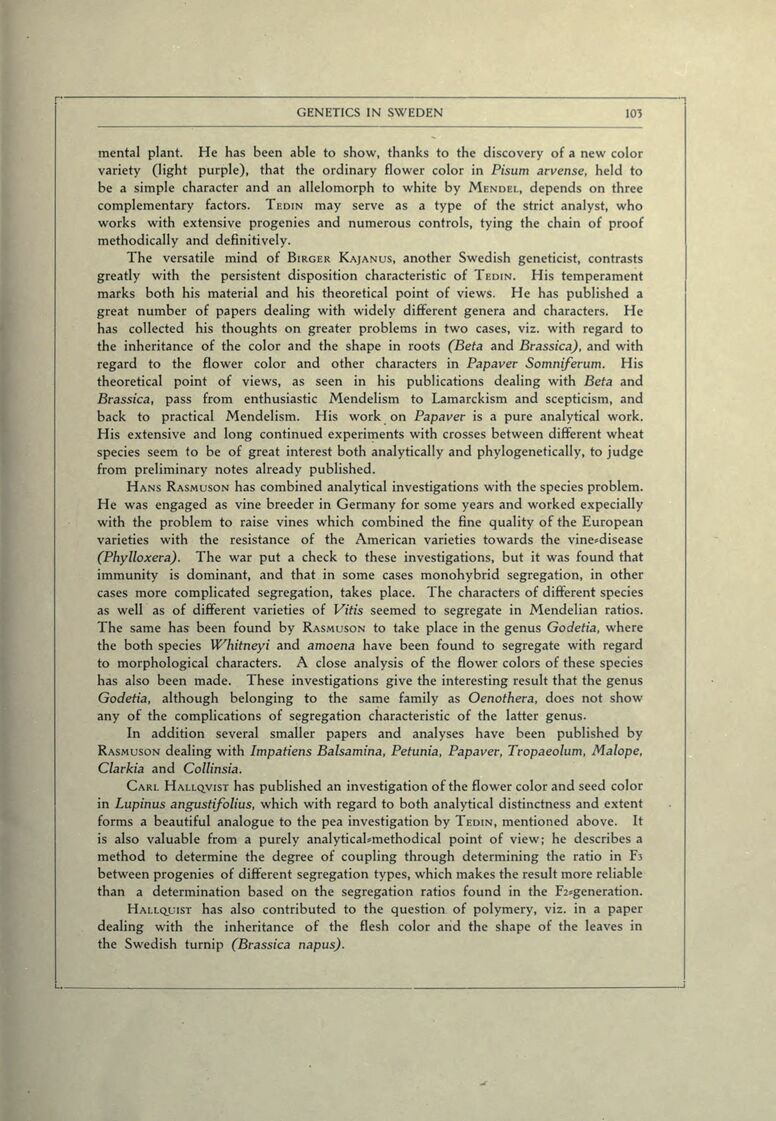
Full resolution (JPEG) - On this page / på denna sida - Part I - Docent N. Heribert-Nilsson, Lund, Genetics in Sweden

<< prev. page << föreg. sida << >> nästa sida >> next page >>
Below is the raw OCR text
from the above scanned image.
Do you see an error? Proofread the page now!
Här nedan syns maskintolkade texten från faksimilbilden ovan.
Ser du något fel? Korrekturläs sidan nu!
This page has never been proofread. / Denna sida har aldrig korrekturlästs.
r––––––––––––––––––––––––––––––––––––––––-•
GENETICS IN SWEDEN 103
mental plant. He has been able to show, thanks to the discovery of a new color
variety (light purpie), that the ordinary flower color in Pisum arvense, held to
be a simple character and an allelomorph to white by Mendei., depends on three
complementary factors. Tedin may serve as a type of the strict analyst, who
works with extensive progenies and numerous Controls, tying the chain of proof
methodically and definitively.
The versatile mind of Birger Kajanus, another Swedish geneticist, contrasts
greatly with the persistent disposition characteristic of Tedin. His temperament
marks both his material and his theoretical point of views. He has published a
great number of papers dealing with widely dififerent genera and characters. He
has collected his thoughts on greater problems in two cases, viz. with regard to
the inheritance of the color and the shape in roots (Beta and Brassica), and with
regard to the flower color and other characters in Papaver Somniferum. His
theoretical point of views, as seen in his publications dealing with Beta and
Brassica, pass from enthusiastic Mendelism to Lamarckism and scepticism, and
back to practical Mendelism. His work on Papaver is a pure analytical work.
His extensive and long continued experiments with crosses between dififerent wheat
species seem to be of great interest both analytically and phylogenetically, to judge
from preliminary notes already published.
Hans Rasmuson has combined analytical investigations with the species problem.
He was engaged as vine breeder in Germany for some years and worked expecially
with the problem to raise vines which combined the fine quality of the European
varieties with the resistance of the American varieties towards the vine*disease
(Phylloxera). The war put a check to these investigations, but it was found that
immunity is dominant, and that in some cases monohybrid segregation, in other
cases more complicated segregation, takes place. The characters of dififerent species
as well as of dififerent varieties of Hifis seemed to segregate in Mendelian ratios.
The same has been found by Rasmuson to take place in the genus Godetia, where
the both species Whitneyi and amoena have been found to segregate with regard
to morphological characters. A close analysis of the flower colors of these species
has also been made. These investigations give the interesting result that the genus
Godetia, although belonging to the same family as Oenothera, does not show
any of the complications of segregation characteristic of the latter genus.
In addition several smaller papers and analyses have been published by
Rasmuson dealing with Impatiens Balsamina, Petunia, Papaver, Tropaeolum, Malope,
Clarkia and Collinsia.
Carl Hallqvist has published an investigation of the flower color and seed color
in Lupinus angustifolius, which with regard to both analytical distinctness and extent
forms a beautiful analogue to the pea investigation by Tedin, mentioned above. It
is also valuable from a purely analyticabmethodical point of view; he describes a
method to determine the degree of coupling through determining the ratio in F3
between progenies of dififerent segregation types, which makes the result more reliable
than a determination based on the segregation ratios found in the F2=generation.
Hallquist has also contributed to the question of polymery, viz. in a paper
dealing with the inheritance of the flesh color and the shape of the leaves in
the Swedish turnip (Brassica napus).
<< prev. page << föreg. sida << >> nästa sida >> next page >>